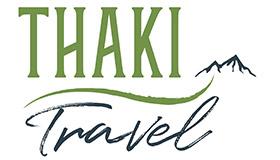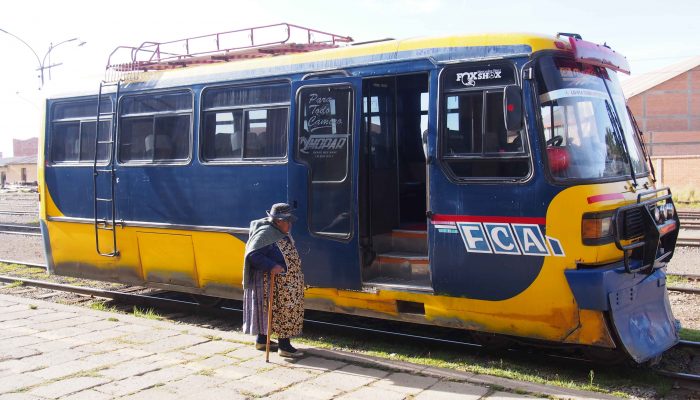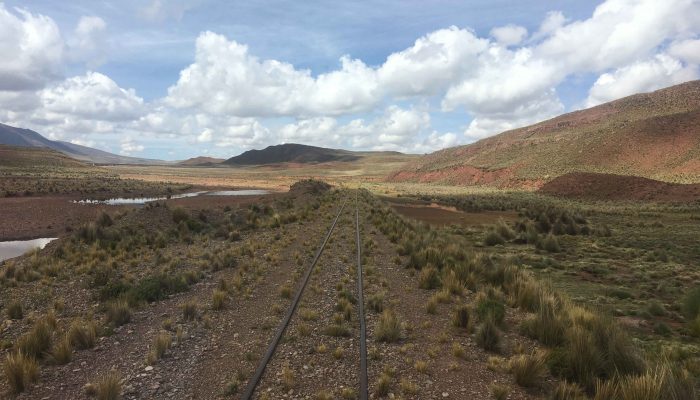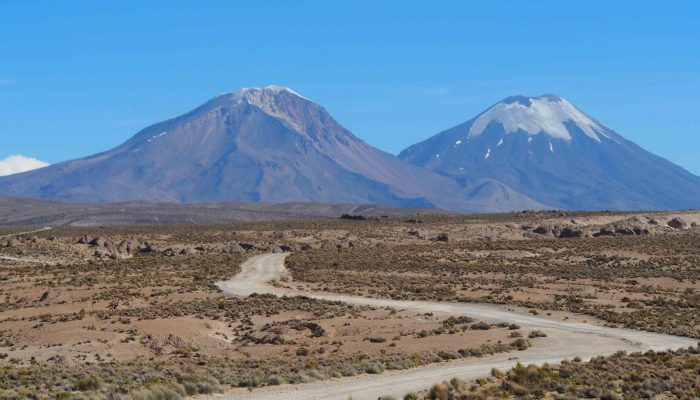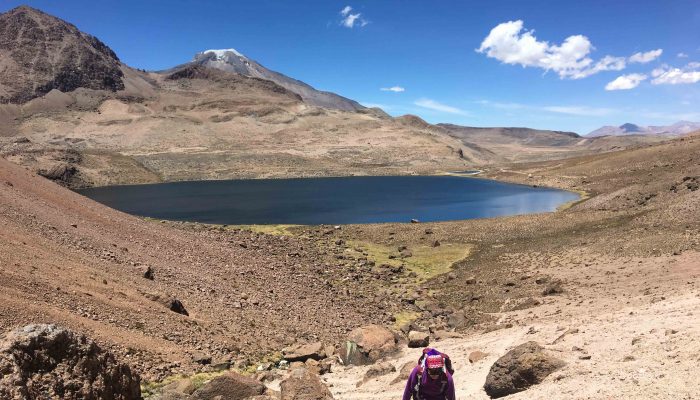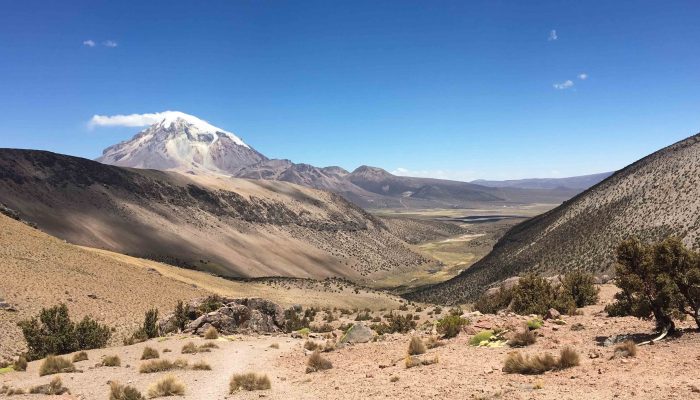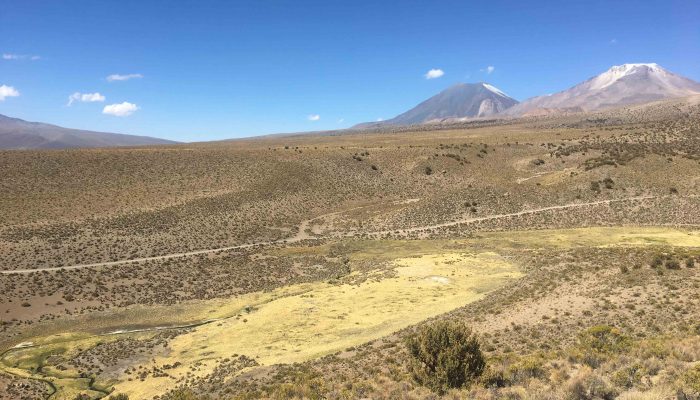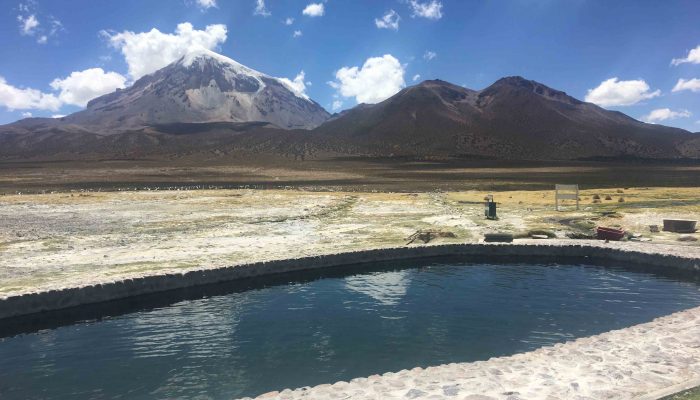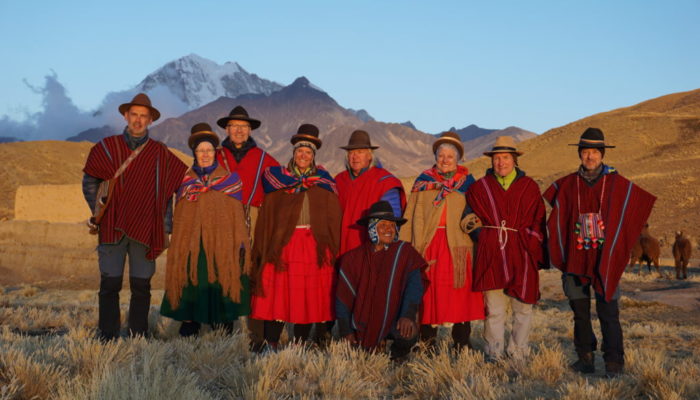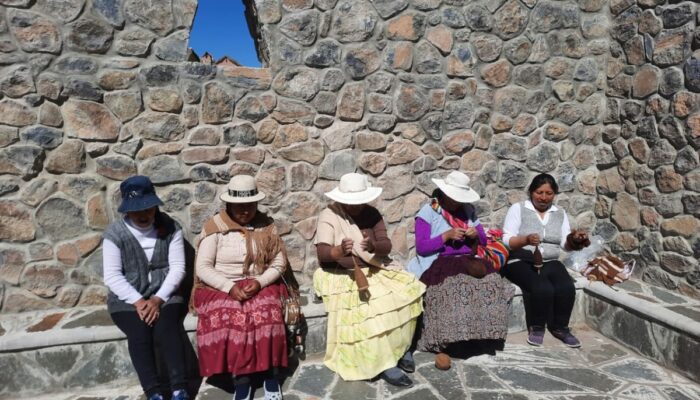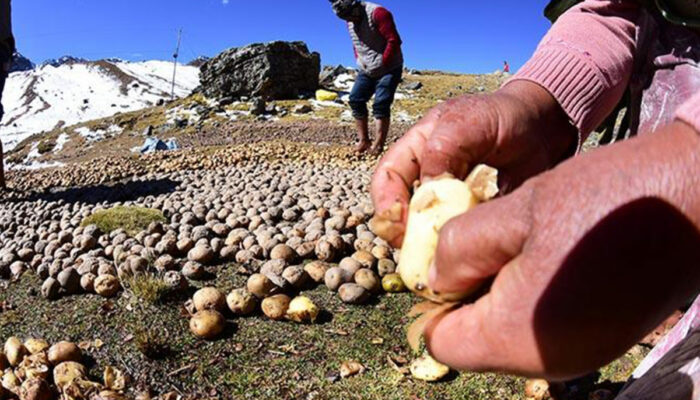As usual, Team Thaki is off on an adventure to discover new and ever more innovative tours, to make your trip with us to Bolivia unforgettable.
We’re heading for Sajama National Park, in the Andes, on the border with Chile. The park is full of surprises: hikes in the mountains, lagoons perched at an altitude of almost 5,000 m, walks through geysers, bathing in 38-degree thermal waters, and for the more courageous, the ascent of the Sajama volcano, Bolivia’s highest peak at 6,542 m.
For even more fun, we’ve chosen a most unusual means of transport, one that you’ll only find in Bolivia: the Bus Carril. Imagine a bus, with seats, a steering wheel and a gearbox …. but with steel wheels instead of tyres, and a railway instead of a road. This half-bus, half-train serves Charaña (6km from Chile) from Viacha, 207 km in 6h-7h, 10 stops, twice a week on Mondays and Thursdays.
We’re going to tell you all about these 3 very rewarding days, during which we learnt a lot and saw a lot!
Day 1: The Carril Bus experience:
We wake up bright and early to find Santos, our guide for this tour. At 5.30am we set off for Viacha, a small town 22km from El Alto. La Paz is slowly waking up, with the city lights still on and the sun rising. The illimani shines above the beautiful clouds that colour the sky. No regrets about waking up so early, this magnificent panorama of the city was well worth the effort.
Once in Viacha, we look for the train station, with its small blue entrance. Some women, already waiting on the platform, confirmed that the train would be leaving at 8.30am, but ticket sales wouldn’t open for another hour. Places are limited and departures rare, so it’s best to arrive early to avoid missing out. The Carril Bus enters the station in reverse, a Mercedes. It makes us smile. There are only locals travelling, some of them heavily laden with those big colourful cloths on their backs. We say hello to Santos, who will be taking the car to meet us on arrival at Charaña. Departure was delayed, and we waited for the friend of a passenger who was on her way, an example of Bolivian courtesy and punctuality. We finally left Viacha station through a sort of garage door, under a beautiful blue sky, shaving the walls.
We cross the city and very quickly find ourselves in the middle of nowhere, admiring some typically Bolivian landscapes. You’re lulled to sleep by the movement of the train, which waddles from left to right, against a backdrop of Latin music, with the occasional whistle. You’d think you were on a train, but when you look up and see the steering wheel and gearbox, you automatically smile as you realise what a unique experience you’re having. On several occasions, we cross roads, and a little honk from the driver, Raul, is enough to dissuade cars, for want of road signs. We also come across llamas and vicuñas blocking the way. If you keep your eyes peeled, you can see mink and even flamingos. The dogs can be heard barking and systematically chasing the train. We managed to get away from them, thanks to our 40 km/h speed. The train stopped several times to let passengers on and off, sometimes in the middle of nowhere, like the cholita who had gone up to sell her mutton cheese. At around 11am, the train stops dead, apparently because it’s lunchtime, and everyone gets off. It also stops us in front of some pre-Columbian tombs, the Casa Chullpa, and lets us get off to take some photos. Afterwards, the driver turns on the TV and shows a film that really grabs the attention of the passengers. The journey is very lively, and goes much faster than expected. We skirt the Rio Mauri, then start to catch sight of a snow-capped peak, the Sajama.
Once we arrived at Charaña station, a tiny village of little interest, we found Santos patiently waiting for us. We climbed into the 4X4 and set off along the track that links Charaña to Sajama. It’s a 3.5 hour journey through beautiful countryside, with the Sajama in the background for most of the way, as well as the 2 twins, Pomarapi and Parinaconta. There’s no shortage of llamas and alpacas in this region, and we’re in for a treat.
Once we arrived in the village of Sajama, at an altitude of 4,300m, we headed for the Hotel Oasis, where Marcelo, the owner, was waiting for us with mate and cakes. Shortly afterwards, we were served a hearty dinner, and it wasn’t long before we were off to bed. It had been an intense day, and tomorrow will be just as intense.
Day 2: A beautiful day’s hiking between mountains, geysers and lagoons
Santos and I set off at 8am in the direction of the Geysers. The car was a great help, as it meant we didn’t have to tire ourselves out walking along paths that weren’t necessarily interesting. We went down to walk between the fumes of the bubbling geysers. It was a lovely sight in the morning light. We then continued to the car park where the 4-5 hour round trip hike began.
The walk has an altitude difference of over 600m. We pass the first lagoon, Kasiri, at 4,850m, then the second, Sorapata, at 4,950m, where we take a picnic break in front of a magnificent, colourful mountain. Just before passing the first lagoon, we come to a sign marking the border with Chile: on one side it says “Bolivia” and on the other “Chile”. Chile has never been so close, with the Chilean tracks just across the road and a few gendarmes guarding the border. Indeed, the Kasiri lagoon is ¾ Chilean and ¼ Bolivian. Throughout the hike, we learn a lot from Santos, a real living encyclopaedia, about the flora and fauna, the culture and customs of the inhabitants, the mountains, etc. The return journey takes the same route, but this time with a view of a completely clear Sajama – Majestic!
We return to the hotel at around 3pm to collect our swimming costumes, and Santos takes us to the thermal baths, which are not known to tourists and have no changing rooms or facilities. A small natural pool at 38 degrees, right in front of the Sajama. Incredible view as we relax our muscles. Back to the hotel at the end of the day for a rest, a snack and dinner.
Day 3: Another hike, even more thermal baths, and back to La Paz
Departure at 8.30 am, this time with a local guide, Marcelo’s father Santiago. At 64, he’s still keeping up a good walking pace. Another 2-3 hour hike, flatter but just as pleasant, starting with a path just behind the geysers and going deeper to reach the tourist hot springs. We take the opportunity to spend some time around the geysers again. Along the way, we come across herds of llamas and alpacas, some of them very curious and approaching us a little closer. The Sajama is always in the background, facing us throughout the hike.
This is the “tourist” version of the thermal waters. The pool is larger, and changing rooms and toilets are available. The view is no less beautiful, although the Sajama may seem a little further away than from the thermal baths yesterday. After 2 intense days, we relax for a good hour in the very hot water and enjoy the last views of the park.
After a final lunch at Marcelo’s, a good salmon trout caught in the lake this morning, we hit the road for a leisurely drive to La Paz (around 4 hours). The journey by car is also very beautiful and well worth the effort: different mountainous reliefs, atypical rock formations, varied colours, ochres, earths, reddish clays, which give us an impression of Arizona. Then those yellowish/greenish shrubs reappear, the paja brava and the itchu, to remind us that we are indeed in Bolivia. We make one last stop at a viewpoint on the road, where there are more pre-Columbian tombs, and Santos gives us a little history lesson. Then we start to see Qimsacruz, an offshoot of the Cordillera Real, and finally Illimani. La Paz is just around the corner, and we arrive there at around 6pm.
What a magnificent tour! Our heads are full of memories and beautiful images! A big thank you to Santos for his perfect driving and his knowledge, which made the rides even more interesting.
